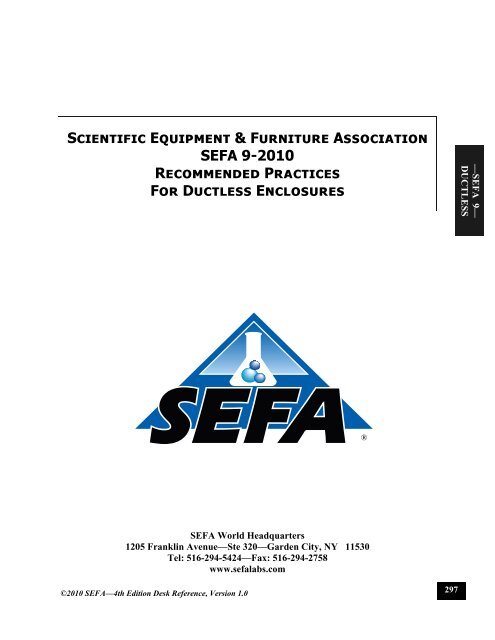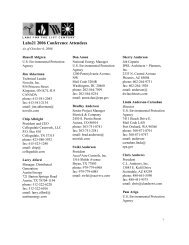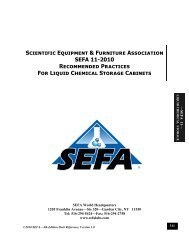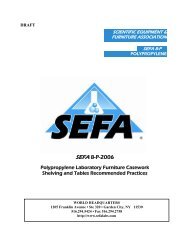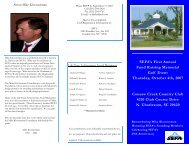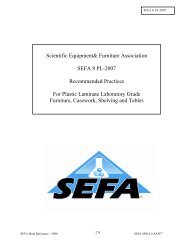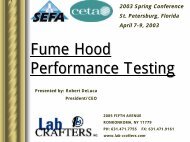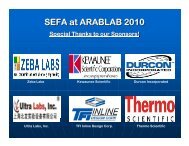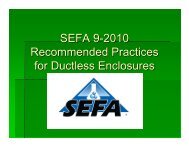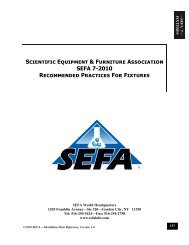Download SEFA-9-2010-Ductless.pdf - Scientific Equipment and ...
Download SEFA-9-2010-Ductless.pdf - Scientific Equipment and ...
Download SEFA-9-2010-Ductless.pdf - Scientific Equipment and ...
- No tags were found...
Create successful ePaper yourself
Turn your PDF publications into a flip-book with our unique Google optimized e-Paper software.
<strong>Scientific</strong> <strong>Equipment</strong> & Furniture Association<br />
<strong>SEFA</strong> 9-<strong>2010</strong><br />
Recommended Practices<br />
For <strong>Ductless</strong> Enclosures<br />
—<strong>SEFA</strong> 9—<br />
DUCTLESS<br />
®<br />
<strong>SEFA</strong> World Headquarters<br />
1205 Franklin Avenue—Ste 320—Garden City, NY 11530<br />
Tel: 516-294-5424—Fax: 516-294-2758<br />
www.sefalabs.com<br />
©<strong>2010</strong> <strong>SEFA</strong>—4th Edition Desk Reference, Version 1.0 297
TABLE OF CONTENTS<br />
—<strong>SEFA</strong> 9—<br />
DUCTLESS<br />
Page<br />
Committee Members ………………… 299<br />
Forward …………………………….… 300<br />
Sections<br />
1.0 Scope ……………………………… 301<br />
2.0 Purpose …………………………… 301<br />
3.0 <strong>Ductless</strong> Hood Defined …………... 301<br />
3.1 <strong>Ductless</strong> Hood Scope of<br />
Application Defined<br />
4.0 <strong>Ductless</strong> Hood – Types ………….. 301<br />
4.1 <strong>Ductless</strong> Hood Filtration Categories<br />
4.1.1 DH I<br />
4.1.2 DH II<br />
4.1.3 DH III<br />
4.2 Manufacturer Approved Applications/<br />
Misuse Prevention - As Manufactured<br />
4.2.1 Manufacturer’s H<strong>and</strong>book<br />
4.2.2 Manufacturer Approved<br />
Application Questionnaire Form<br />
<strong>SEFA</strong> 9-A<br />
4.2.3 Filter Saturation Detection<br />
DH II/III<br />
4.2.4 Face Velocity Monitoring<br />
DH II/III<br />
4.3 <strong>SEFA</strong> 9 Benchmark Testing –<br />
As Manufactured<br />
4.3.1 Filtration <strong>and</strong> Containment<br />
4.3.2 Independent Testing <strong>and</strong><br />
Validation<br />
4.4 Markings<br />
5.0 <strong>Ductless</strong> Hoods – As used ………... 306<br />
5.1 Safe Work Practices<br />
5.2 Recommended Usage Precautions<br />
5.2.1 DH I<br />
5.2.2 DH II<br />
5.2.3 DH III<br />
5.3 Manufacturer Approved Applications –<br />
As Used<br />
5.3.1 Manufacturer Approved<br />
Application Response Form<br />
<strong>SEFA</strong> 9-A<br />
5.4 Dedicated Usage/Change of<br />
Application Procedures/Monitoring<br />
5.5 Dedicated Usage Markings–As used<br />
5.6 Contaminated Filter H<strong>and</strong>ling<br />
Procedures<br />
Page<br />
6.0 <strong>Ductless</strong> Hoods - As Installed ……. 307<br />
6.1 Test Protocol<br />
6.2 Frequency of Testing<br />
7.0 Reference Organizations …………. 308<br />
7.1 Filtration <strong>and</strong> Exposure Limitations<br />
7.2 Containment<br />
<strong>SEFA</strong> Form 9-A ……………………….. 309<br />
298<br />
©<strong>2010</strong> <strong>SEFA</strong>—4th Edition Desk Reference, Version 1.0
<strong>SEFA</strong> 9 — <strong>Ductless</strong> Enclosures Committee Members<br />
Kevin Gilkison, Chairman …………………..………. Labconco<br />
Greg Dobbyn, Co-Chairman …………….………...... AirClean Systems<br />
Stephan Hauville, Founding Chairman ……………. Erlab<br />
Ben Chemelli …………………………………………. AirClean Systems<br />
Ken Dixon ………. ……………………………….….. Air Control<br />
Andre Chambre ……………………………………..….. Air Science<br />
—<strong>SEFA</strong> 9—<br />
DUCTLESS<br />
Don Nelson………. ……………………………….….. Air Master Systems<br />
Jim Hill ………………………………………………… BSA Life Structures<br />
Karl Aveard …… ………………………………….….. Erlab<br />
Gregory Cook …………………………………………. Erlab<br />
Tom Smith ……………………………………………. Exposure Control Technologies<br />
Ron Hill ………………………………………………. HEMCO Corp.<br />
Kurt Rindoks …………………………………………. Kewaunee <strong>Scientific</strong><br />
Larry Hambleton …………………………………….<br />
Tom Schwaller ………………………………………..<br />
Labconco<br />
Labconco<br />
Robert Deluca ………………………………………… Lab Crafters<br />
Ron Manna …………………………………………… Misonix<br />
Jon Zboralski …………………………………………. Thermo Fisher <strong>Scientific</strong><br />
©<strong>2010</strong> <strong>SEFA</strong>—4th Edition Desk Reference, Version 1.0 299
Forward<br />
<strong>SEFA</strong> Profile<br />
—<strong>SEFA</strong> 9—<br />
DUCTLESS<br />
The <strong>Scientific</strong> <strong>Equipment</strong> <strong>and</strong> Furniture Association (<strong>SEFA</strong>) is an international trade association comprised<br />
of manufacturers of laboratory furniture, casework, fume hoods <strong>and</strong> members of the design <strong>and</strong><br />
installation professions. The Association was founded to promote this rapidly exp<strong>and</strong>ing industry <strong>and</strong><br />
improve the quality, safety <strong>and</strong> timely completion of laboratory facilities in accordance with customer<br />
requirements.<br />
<strong>SEFA</strong> Recommended Practices<br />
<strong>SEFA</strong> <strong>and</strong> its committees are active in the development <strong>and</strong> promotion of Recommended Practices having<br />
domestic <strong>and</strong> international applications. Recommended Practices are developed by the association<br />
taking into account the work of other st<strong>and</strong>ard-writing organizations. Liaison is also maintained with<br />
government agencies in the development of their specifications.<br />
<strong>SEFA</strong>’s Recommended Practices are developed in <strong>and</strong> for the public interest. These practices are designed<br />
to promote a better underst<strong>and</strong>ing between designers, architects, manufacturers, purchasers, <strong>and</strong><br />
end-users <strong>and</strong> to assist the purchaser in selecting <strong>and</strong> specifying the proper product to meet the user’s<br />
particular needs. <strong>SEFA</strong>’s Recommended Practices are periodically updated. The Recommended Practices<br />
are numbered to include an annual suffix which reflects the year that they were updated. <strong>SEFA</strong><br />
encourages architects to specify these Recommended Practices as follows: “<strong>SEFA</strong> 9-<strong>2010</strong>”.<br />
<strong>SEFA</strong> Glossary of Terms<br />
<strong>SEFA</strong> has developed a Glossary of Terms (<strong>SEFA</strong> 4-<strong>2010</strong>) for the purpose of promoting a greater underst<strong>and</strong>ing<br />
between designers, architects, manufacturers, purchasers <strong>and</strong> end users. The terms defined by<br />
<strong>SEFA</strong> are frequently used in contracts <strong>and</strong> other documents, which attempt to define the products to be<br />
furnished or the work involved. The Association has approved this Glossary in an effort to provide uniformity<br />
among those who use these terms. Where a specific Recommended Practice contains definitions<br />
which differ from those in the Glossary of Terms, then the definitions in the specific Recommended<br />
Practice should be used.<br />
<strong>SEFA</strong> encourages all interested parties to submit additional terms or to suggest any changes to those<br />
terms already defined by the Association. The definitions should be used to help resolve any disputes<br />
that may arise or to incorporate the applicable terms in any contract or related documents.<br />
<strong>SEFA</strong> Disclaimer<br />
<strong>SEFA</strong> uses its best effort to promulgate Recommended Practices for the benefit of the public in light of<br />
available information <strong>and</strong> accepted industry practices. <strong>SEFA</strong> does not guarantee, certify, or assure the<br />
safety or performance of any products, components, or systems tested, installed, or operated in accordance<br />
with <strong>SEFA</strong> Recommended Practices or that any tests conducted under its Recommended Practices<br />
will be non-hazardous or free from risk. <strong>SEFA</strong> encourages the use of third party independent testing<br />
where appropriate.<br />
300<br />
©<strong>2010</strong> <strong>SEFA</strong>—4th Edition Desk Reference, Version 1.0
1.0 Scope<br />
These <strong>SEFA</strong> Recommended Practices provide<br />
a comprehensive single source of knowledge<br />
pertaining to laboratory <strong>Ductless</strong> Hoods. Since<br />
the <strong>Ductless</strong> Hood is a re-circulating filtration<br />
device, which is not integral to the laboratory<br />
ventilation system, these practices will primarily<br />
address issues relating to filtration, product<br />
usage, feasibility, safety <strong>and</strong> limitations as well<br />
as manufacturer usage recommendations <strong>and</strong><br />
manufacturer responsibility.<br />
2.0 Purpose<br />
To allow for the correct use <strong>and</strong> application of<br />
ductless hoods.<br />
The purpose of these Recommended Practices<br />
is to establish manufacturer’s requirements for<br />
the general design <strong>and</strong> testing of <strong>Ductless</strong><br />
Hoods as well as guidelines <strong>and</strong> procedures for<br />
the correct specification, use, maintenance <strong>and</strong><br />
testing of <strong>Ductless</strong> Hoods These requirements,<br />
guidelines <strong>and</strong> procedures are for <strong>Ductless</strong><br />
Hoods that are used to protect personnel from<br />
harmful exposure to contaminants generated<br />
within the ductless hood. The individual<br />
manufacturer recommendations must be followed<br />
for each specific application <strong>and</strong> usage.<br />
3.0 <strong>Ductless</strong> Hood Defined<br />
A ductless hood, a/k/a (but not limited to)<br />
<strong>Ductless</strong> Fume Hood, <strong>Ductless</strong> Filtering Fume<br />
Enclosure, Portable Hood, Carbon Filtered Enclosure,<br />
Enclosure for Toxins using Recirculating<br />
Air Filtration ( E.T.R.A.F.) is an<br />
enclosure designed for the h<strong>and</strong>ling of contaminants,<br />
which limits the propagation toward<br />
the operator <strong>and</strong> other personnel of such contaminants.<br />
Typically, it is not attached to any<br />
external exhaust system. A <strong>Ductless</strong> Hood is<br />
equipped with its own independent ventilation<br />
system which forces the contaminated air to<br />
travel through a filter <strong>and</strong> re-circulates it within<br />
the room.<br />
3.1 <strong>Ductless</strong> Hood Scope of Application<br />
Defined<br />
<strong>Ductless</strong> Hoods do not have the same scope of<br />
application as st<strong>and</strong>ard laboratory Fume<br />
Hoods, Biological Safety Cabinets, or potent<br />
compound hoods. <strong>Ductless</strong> Hoods are only<br />
suitable for use with identified, manufacturer<br />
approved applications.<br />
4. 0 <strong>Ductless</strong> Hood – Types<br />
4.1 <strong>Ductless</strong> Hood Filtration Categories<br />
4.1.1 DH I<br />
A ductless hood equipped with a filtration device<br />
designed to control non-toxic chemicals,<br />
nuisance odors, particulates.<br />
4.1.2 DH II<br />
A ductless hood capable of meeting all DH I<br />
requirements, <strong>and</strong> equipped with a filtration<br />
device designed to filter manufacturer approved<br />
toxic contaminants up to filter break<br />
through only. A DH II ductless hood is not<br />
designed to provide secondary containment<br />
beyond primary filter break through.<br />
4.1.3 DH III<br />
A ductless hood capable of meeting all DH II<br />
requirements, <strong>and</strong> equipped with a filtration<br />
device designed to filter manufacturer approved<br />
toxic contaminants beyond primary filter<br />
break through by providing secondary backup<br />
protection. Once the primary filter break<br />
through point has been detected a DH III ductless<br />
hood should be designed to provide a period<br />
of time to continue <strong>and</strong> end an ongoing<br />
experiment with its secondary back-up filter<br />
system. The secondary filter must be of the<br />
same type of media <strong>and</strong> efficacy, as the primary<br />
filter.<br />
—<strong>SEFA</strong> 9—<br />
DUCTLESS<br />
©<strong>2010</strong> <strong>SEFA</strong>—4th Edition Desk Reference, Version 1.0 301
—<strong>SEFA</strong> 9—<br />
DUCTLESS<br />
302<br />
4.2 Manufacturer Approved Applications<br />
/ Misuse Prevention-As Manufactured<br />
4.2.1 Manufacturer’s Performance Information<br />
A <strong>Ductless</strong> Hood regardless of Category is<br />
limited by the capabilities of its filtration<br />
system. The manufacturer’s performance information,<br />
must be supplied for each DH II <strong>and</strong><br />
III <strong>Ductless</strong> Hood, <strong>and</strong> is designed to clearly<br />
outline manufacturer approved applications <strong>and</strong><br />
usage limitations <strong>and</strong> shall at least include the<br />
following:<br />
A definition of <strong>Ductless</strong> Hood Categories identical<br />
to the one outlined in these Recommended<br />
Practices.<br />
A copy of the <strong>SEFA</strong> 9 test results for the “as<br />
manufactured” performance test for both filtration<br />
<strong>and</strong> containment as per section 4.3 validated<br />
by an independent recognizable third<br />
party, showing retention capacities in grams/<br />
ounces for each compatible filter type. For<br />
example, this would be the retention capacity<br />
of the filter as stated by the manufacturer prior<br />
to releasing 50% of the TLV/PEL of the toxic<br />
contaminant for DH II <strong>and</strong> 1% of the TLV/PEL<br />
of the toxic contaminant for DH III.<br />
4.2.2 Manufacturer Approved Application<br />
Questionnaire Form <strong>SEFA</strong> 9-A<br />
Prior to approving usage, a qualified specialist<br />
or department within the manufacturer or supplier<br />
of the <strong>Ductless</strong> Hood should review all<br />
applications <strong>and</strong> determine for each the compatibility<br />
or incompatibility of the ductless<br />
hood by using form <strong>SEFA</strong> 9-A. Form <strong>SEFA</strong> 9-<br />
A is a st<strong>and</strong>ardized form designed to cover all<br />
pertinent questions regarding the intended usage<br />
of a ductless hood, <strong>and</strong> is necessary to determine<br />
<strong>and</strong> subsequently approve or deny usage.<br />
The following list represents the minimum information<br />
to be provided by the customer:<br />
• Date<br />
• Customer’s company name <strong>and</strong> address<br />
• Customer contact name <strong>and</strong> phone#<br />
• Intended application including list all<br />
equipment to be used inside hood<br />
• Name of each material planned on being<br />
used <strong>and</strong> Chemical ID i.e., CAS#, EN#, etc<br />
• Amount of each material<br />
• Concentration of material i.e., full strength,<br />
dilute, percentage<br />
• Frequency <strong>and</strong> duration of the application<br />
• Temperature of material<br />
• Type of container used <strong>and</strong> is the container<br />
covered or open<br />
• Evaporation Rate<br />
• Maximum potential spill volume<br />
• Truthful <strong>and</strong> accurate statement<br />
Completed by Manufacturer—Refer to § 5.3.1.<br />
In the case of a manufacturer/supplier approved<br />
application, the resulting document shall provide<br />
all necessary information, as detailed in<br />
“As Used” section 5.3, for the correct use <strong>and</strong><br />
maintenance of the ductless hood.<br />
4.2.3 Filter Saturation Detection DH II/III<br />
DH II <strong>and</strong> III <strong>Ductless</strong> Hoods require constant<br />
monitoring of filter saturation breakthrough<br />
<strong>and</strong> should be designed with a continuous audible<br />
<strong>and</strong> visual automatic saturation detection<br />
monitoring device able to detect all manufacturer<br />
approved toxic contaminants. The efficacy<br />
of the device should be such that when<br />
break through occurs, test measurements taken<br />
downstream from the filter must not exceed<br />
50% of the TLV of the manufacturer approved<br />
toxic contaminant(s) for DH II <strong>Ductless</strong> Hoods<br />
<strong>and</strong> 1% of the TLV of the manufacturer approved<br />
contaminant(s) for DH III <strong>Ductless</strong><br />
Hoods. The means necessary to insure the<br />
proper functioning <strong>and</strong> manual verification of<br />
the automatic filter saturation detection device<br />
should also be provided. The frequency of the<br />
verification shall be recommended by the<br />
manufacturer, but be the responsibility of the<br />
©<strong>2010</strong> <strong>SEFA</strong>—4th Edition Desk Reference, Version 1.0
EH&S officer.<br />
4.2.4 Face Velocity Monitoring DH II / III<br />
A permanent face velocity monitoring device<br />
should be incorporated within all DH II <strong>and</strong> III<br />
ductless hoods. The monitoring device should<br />
be calibrated by a face velocity traverse as recommended<br />
in ASHRAE 110-95 using the average<br />
as the set point. To ensure proper performance<br />
as recommended by the manufacturer testing<br />
should be performed at least annually.<br />
4.3 <strong>SEFA</strong> 9 Benchmark Testing –<br />
As Manufactured<br />
4.3.1 Filtration <strong>and</strong> Containment<br />
DH I:<br />
Nuisance odors only. No testing required.<br />
DH II <strong>and</strong> III:<br />
If manufacturers require more than one filter<br />
media type to perform the benchmark test<br />
chemicals, testing should then be performed<br />
using the appropriate filter media type.<br />
Benchmark - Testing procedure:<br />
This test is applicable to only Class II <strong>and</strong><br />
Class III hoods. It is not intended for Class I<br />
type hoods used for nuisance <strong>and</strong> non toxic<br />
odors<br />
Calibration of testing equipment— please refer<br />
to ASHRAE 110-95 for calibration guidelines.<br />
Hood setup <strong>and</strong> face velocity measurements—<br />
the ductless hood shall be setup per manufacturer’s<br />
recommendations in a location that has<br />
average cross draft of less than 30 fpm when<br />
measured 18 inches out from the face of the<br />
hood at the left <strong>and</strong> right side of the sash opening.<br />
Face velocity measurements are made by<br />
establishing an imaginary grid pattern equally<br />
divided in the vertical <strong>and</strong> horizontal positions<br />
<strong>and</strong> taking velocity readings at each grid point.<br />
Readings should be taken each second for a<br />
period of 30 seconds <strong>and</strong> averaged. Determine<br />
the average of each grid position. The measured<br />
deviation shall not vary more than +/-<br />
20% of the overall average. Cross draft <strong>and</strong><br />
airflow velocity measurements are made using<br />
a hot wire calibrated anemometer. Test each<br />
model (Type Test) or after modification to unit<br />
or filter. The hood face velocity shall be set by<br />
the ductless hood manufacturer. (Refer to<br />
<strong>SEFA</strong> 1-<strong>2010</strong> Section 4.3 <strong>and</strong>/or ANSI/<br />
ASHRAE 110-1995 6.2 Face Velocity Measurements<br />
or most curent version).<br />
Flow Visualization — discharge smoke from a<br />
smoke stick along the walls <strong>and</strong> work surface<br />
of the hood six inches back from the front of<br />
the unit. Smoke shall be carried to the back or<br />
top of the hood <strong>and</strong> be exhausted with little<br />
reverse movement. Particular attention shall be<br />
given to the corners. At no time shall smoke<br />
escape out the hood, except through the filtered<br />
exhaust. If smoke does escape out the front of<br />
the hood the hood fails the test. The filter seals<br />
<strong>and</strong> other areas of the hood where contaminate<br />
could escape shall be under negative pressure.<br />
Containment Testing. (Refer to ASHRAE 110-<br />
1995 or most current version for specific details.)<br />
— place an exhaust duct with canopy<br />
style connection from an exhaust system with<br />
variable control over the exhaust port of the<br />
ductless hood. The exhaust system shall be set<br />
to exhaust a greater CFM than the ductless<br />
hood requires to keep any contaminates from<br />
the exhaust from leaking into the test room.<br />
Once the external exhaust system is operating,<br />
face velocity readings shall be retaken <strong>and</strong><br />
match those previously taken with the external<br />
exhaust system off. If the face velocities have<br />
changed, reduce the exhaust system CFM to<br />
where there is no effect on the hood face velocities.<br />
The exhaust on the system must be<br />
great enough to keep the exhaust plenum area<br />
negative, but not so strong that the face velocities<br />
on the hood are affected.<br />
Use an ITI Leak Meter or other continuous<br />
reading instrument specific for sulfur<br />
hexafluoride gas capable of 0.01 ppm detection<br />
or less.<br />
—<strong>SEFA</strong> 9—<br />
DUCTLESS<br />
©<strong>2010</strong> <strong>SEFA</strong>—4th Edition Desk Reference, Version 1.0 303
—<strong>SEFA</strong> 9—<br />
DUCTLESS<br />
304<br />
Position the manikin in front of the hood, in a<br />
sitting position with the sampling probe 1.5"<br />
above the bottom of the sash <strong>and</strong> 3" out from<br />
the bottom sash edge. The sash shall be placed<br />
in the “designed sash position.” The tracer gas<br />
test is run with the ejector placed 6 inches behind<br />
the plane of the face opening in three different<br />
positions. These positions are 12 inches<br />
from the right <strong>and</strong> left sides of the hood <strong>and</strong> at<br />
the center line of the hood. Release sulfur<br />
hexafluoride tracer gas at the rate of 4 liters/<br />
minute. Determine tracer gas concentration<br />
using leak meter or other continuous reading<br />
instrument. Remove the manikin <strong>and</strong> scan the<br />
perimeter of the sash <strong>and</strong> airfoil of the hood<br />
using the leak meter probe, holding the probe<br />
approximately one inch from the hood opening.<br />
No leakage of tracer gas shall be greater than<br />
an average of 0.05 ppm in any position. Refer<br />
to ASHRAE 110-1995 for instrumentation,<br />
ejector construction <strong>and</strong> method details.<br />
Filter Efficiency <strong>and</strong> Adsorption Capacity<br />
Tests — with the ductless hood setup per<br />
manufacturer’s recommendation install the appropriate<br />
filter(s) for your test. Turn on the system<br />
<strong>and</strong> allow the hood to stabilize per manufacturer’s<br />
instructions. Record relative humidity<br />
<strong>and</strong> temperature of laboratory before <strong>and</strong><br />
after test. Temperature should be between 18°<br />
C to 22°C <strong>and</strong> relative humidity between 40%<br />
to 60%.<br />
Evaporate one of the following listed chemicals<br />
at the indicated rates:<br />
NIOSH Limits<br />
Evaporation<br />
Chemical Family TLV Rate<br />
HCL 5 ppm 100 ppm<br />
Diethyl Amine 10 ppm 50 ppm<br />
Isopropyl 400 ppm 500 ppm<br />
Toluene 100 ppm 150 ppm<br />
The evaporation rate required is determined by<br />
calculating the mass rate of chemical needed to<br />
mix with the hood air flow (CFM) during test<br />
to create the indicated flow rates.<br />
Suitable ways of evaporation are free surface<br />
evaporation without heat, heating the chemical<br />
in a container on a hot plate or addition of the<br />
chemical into a metal or ceramic cup heated by<br />
a hot plate using a peristaltic or other high precision<br />
positive displacement pump set to the<br />
required mass flow rate. Control the evaporation<br />
temperature to where degradation of the<br />
chemical does not occur. Example of evaporation<br />
temperature for toluene would be 140° C.<br />
Determine the evaporation rate of the chemical<br />
by weighing the container(s) before <strong>and</strong> after<br />
the evaporation, with an appropriate precision<br />
balance or scale <strong>and</strong> noting weight change per<br />
unit time. When using a pumping device to<br />
pump the chemical into a heated container the<br />
flow rate of the chemical into the container<br />
determines the evaporation rate. When using a<br />
hot plate for evaporation caution must be taken<br />
to keep the hot plate temperature below the<br />
flash point of the chemical to prevent a fire or<br />
explosion or degradation of the chemical. Do<br />
not use open flame to heat the containers. If<br />
additional chemicals are tested <strong>and</strong> sufficient<br />
mass cannot be evaporated to reach a challenge<br />
level of TLV or greater, a lower challenge level<br />
may be permitted as long as it is the maximum<br />
level which can be reasonably obtained <strong>and</strong> the<br />
conditions of the test are recorded.<br />
Monitor the concentration of the test chemical<br />
in the room, in the hood, before the filter <strong>and</strong> in<br />
the exhaust stream past the filter(s) under test<br />
by using a gas chromatograph, mass spectrometer,<br />
FTIR analyzer or PID detector.<br />
Manufacture is to determine sampling points.<br />
Exhaust sampling point must be located in an<br />
area that represents the actual concentration of<br />
the exhaust. Complete mixing at the sampling<br />
point must be validated. The instrumentation<br />
used shall have a minimum detection level of<br />
1% of the TLV or less. In the case where hydrochloric<br />
acid is tested an ion chromatograph<br />
or FTIR is recommended. Colorimetric detection<br />
tubes do not have the necessary resolution<br />
to accurately determine the concentration of the<br />
chemicals <strong>and</strong> shall only be used for the deter-<br />
©<strong>2010</strong> <strong>SEFA</strong>—4th Edition Desk Reference, Version 1.0
mination of HCL, if FTIR or an ion chromatograph<br />
is not available. Continuous sampling of<br />
the exhaust for acid detection can be made by<br />
using a small pump to pull the exhaust sample<br />
through a general acid colorimetric tube for the<br />
purpose of acid detection, at the rate of approximately<br />
1.5 l/min. When the general acid<br />
colorimetric tube begins to turn pink begin<br />
sampling exhaust with HCL acid colorimetric<br />
tube, 1-10 ppm, to determine the exhaust concentration.<br />
Follow manufactures sampling recommendation<br />
when sampling with the HCL<br />
acid 1-10 ppm tube.<br />
Exhaust air from the hood must be sampled at<br />
15 minute time intervals. For sampling of HCL<br />
acid using colorimetric tubes, sampling must<br />
begin two hours before the end point of the test<br />
is achieved. For hoods which incorporate a secondary<br />
filter means, the exhaust of the primary<br />
filter bed ONLY will be sampled, not the exhaust<br />
of the hood itself. Continue evaporation<br />
<strong>and</strong> exhaust sampling until chemical concentration<br />
equals the inlet concentration or the TLV,<br />
whichever is lower. For each data point, record<br />
or calculate the mass of chemical evaporated as<br />
well as chemical concentration levels in the<br />
sampled air streams. Sample <strong>and</strong> record room<br />
concentrations at a sampling point one foot out<br />
from the center point of the sash. In cases<br />
where the time of testing goes beyond 8 hours,<br />
the hood <strong>and</strong> test apparatus shall be turned off<br />
<strong>and</strong> left in a stagnant mode until the next testing<br />
period. During this stagnate mode, the hood<br />
shall be disconnected from any active exhaust<br />
systems to prevent airflow through the filters.<br />
At the beginning of the next test period record<br />
<strong>and</strong> graph all data. Be certain chemical containers<br />
are sealed to prevent evaporation. The test<br />
output shall be a table or graph of the mass of<br />
the test chemical evaporated plotted as the x-<br />
axis vs. the concentration in ppm of the chemical<br />
concentration found in the hood exhaust on<br />
the y-axis. Conditions of the test are to be provided<br />
on the graph or separate list that includes<br />
temperature <strong>and</strong> humidity of the test room,<br />
CFM <strong>and</strong> face velocity, evaporation rate, grade<br />
<strong>and</strong> concentration of the chemical, current<br />
listed TLV, start <strong>and</strong> stop of the test, amount of<br />
filter media <strong>and</strong> type, method of evaporation,<br />
inlet concentration <strong>and</strong> total test time. The<br />
name <strong>and</strong> model number of the unit tested is<br />
also to be provided with the report.<br />
4.3.2 Independent testing <strong>and</strong> validation<br />
The manufacturers’ benchmark testing as described<br />
in 4.3.1 shall be validated by an independent<br />
recognizable third party. Manufacturers<br />
should include a copy of the third party<br />
testing in their technical manual.<br />
4.4 Markings<br />
<strong>Ductless</strong> Hoods should be clearly identified<br />
with the words “DUCTLESS HOOD” prominently<br />
displayed in large letters on the front of<br />
the product in order to differentiate them from<br />
conventional ducted Fume Hoods.<br />
DH ratings, identified in this work practice as<br />
DH I, II <strong>and</strong> III, should also be prominently<br />
displayed in large letters on the front of the<br />
product, along with reference to <strong>SEFA</strong> 9. The<br />
DH I <strong>Ductless</strong> Hood label should contain a<br />
message noting their inability to provide protection<br />
for anything other than nuisance odorous<br />
compounds. The DH II <strong>Ductless</strong> Hood<br />
label should contain a message requiring the<br />
immediate suspension of usage at the time of<br />
saturation detection.<br />
An area on the <strong>Ductless</strong> Hood should be provided<br />
in plain view for the placement of form<br />
<strong>SEFA</strong> 9-A. If removed the form shall let the<br />
following words appear: “NOT RECOM-<br />
MENDED FOR USE WITHOUT CURRENT<br />
APPLICATION APPROVAL FORM <strong>SEFA</strong> 9-<br />
A IN PLACE.”<br />
A sticker stating the recommended sash/door<br />
position should be placed on the enclosure.<br />
The label should also indicate if the ductless<br />
hood is only able to achieve <strong>SEFA</strong> 9 containment<br />
compliance in a specific position.<br />
The filtration device type <strong>and</strong> name should appear<br />
in plain view <strong>and</strong> be easily identifiable by<br />
the operator.<br />
—<strong>SEFA</strong> 9—<br />
DUCTLESS<br />
©<strong>2010</strong> <strong>SEFA</strong>—4th Edition Desk Reference, Version 1.0 305
—<strong>SEFA</strong> 9—<br />
DUCTLESS<br />
306<br />
5.0 <strong>Ductless</strong> Hoods – As used<br />
5.1 Safe Work Practices<br />
Operators should use <strong>Ductless</strong> Hoods in accordance<br />
with their organization’s safety guidelines<br />
<strong>and</strong> have a clear underst<strong>and</strong>ing of the<br />
limitations <strong>and</strong> capabilities of their <strong>Ductless</strong><br />
Hood prior to usage. Always refer to completed<br />
<strong>SEFA</strong> 9A prior to usage. Also refer to<br />
current <strong>SEFA</strong> 1-<strong>2010</strong> Section 6 for applicable<br />
general safe usage recommendations.<br />
5.2 Recommended Usage Precautions<br />
In general, <strong>Ductless</strong> Hoods are not recommended<br />
for usage with unknown chemicals or<br />
reactions. <strong>Ductless</strong> Hood usage should be limited<br />
to manufacturer approved applications<br />
only (section 5.3).<br />
5.2.1 DH I<br />
DH I <strong>Ductless</strong> Hoods should only be recommended<br />
for use with applications that would<br />
normally be performed on the open bench<br />
without protection. DH I <strong>Ductless</strong> Hoods<br />
should not be used with toxic contaminants<br />
5.2.2 DH II<br />
DH II <strong>Ductless</strong> Hoods should not be recommended<br />
for use unless their application has<br />
been pre-approved by the manufacturer/<br />
supplier using form <strong>SEFA</strong> 9-A, which should<br />
be posted on the ductless hood at all times in<br />
accordance with section 5.3.<br />
DH II <strong>Ductless</strong> Hoods should not be recommended<br />
for use with toxic contaminants that do<br />
not have a reported TLV/PEL value.<br />
DH II <strong>Ductless</strong> Hoods should only be recommended<br />
for use with applications where continuous<br />
monitoring <strong>and</strong> detection of filter break<br />
through is available<br />
Since a DH II <strong>Ductless</strong> Hood provides protection<br />
only up to filter break through, its use must<br />
be suspended once filter break through detection<br />
occurs. Refer to section 4.2.3<br />
5.2.3 DH III<br />
DH III <strong>Ductless</strong> Hoods should not be recommended<br />
for use unless their application has<br />
been pre-approved by the manufacturer/<br />
supplier using form <strong>SEFA</strong> 9-A in accordance<br />
with section 5.3.<br />
DH III <strong>Ductless</strong> Hoods should only be recommended<br />
for use with applications where permanent<br />
monitoring <strong>and</strong> detection of filter break<br />
through is available. Refer to section 4.2.3<br />
5.3 Manufacturer Approved<br />
Applications – As Used<br />
The manufacturer or supplier of the <strong>Ductless</strong><br />
Hood should approve all applications prior to<br />
usage. The <strong>Ductless</strong> Hood operator should<br />
limit their usage to the manufacturer approved<br />
applications only. The notion of dedicating a<br />
<strong>Ductless</strong> Hood to a specific manufacturer approved<br />
application plays a crucial role in insuring<br />
safe <strong>Ductless</strong> Hood usage. The formal response<br />
form <strong>SEFA</strong> 9-A given to the <strong>Ductless</strong><br />
Hood operator is a necessary document as it<br />
represents an agreed upon underst<strong>and</strong>ing of<br />
correct dedicated use between the supplier <strong>and</strong><br />
the operator. It is therefore required for <strong>Ductless</strong><br />
Hood manufacturers/suppliers to integrate<br />
within their organization the means necessary<br />
to scientifically approve each potential application.<br />
It is the responsibility of the end user to advise<br />
the manufacturer of the <strong>Ductless</strong> Hood <strong>and</strong><br />
gain the approval of all applications in writing<br />
prior to usage.<br />
5.3.1 Manufacturer Approved Application<br />
Questionnaire Form <strong>SEFA</strong> 9-A<br />
Form <strong>SEFA</strong> 9-A is a st<strong>and</strong>ardized form designed<br />
to answer all pertinent questions regarding<br />
the intended usage of a ductless hood <strong>and</strong><br />
ultimately guide the end-user in the correct use<br />
©<strong>2010</strong> <strong>SEFA</strong>—4th Edition Desk Reference, Version 1.0
of their ductless hood. In the case of a manufacturer/supplier<br />
approved application, form<br />
<strong>SEFA</strong> 9-A should be posted in the space provided<br />
on the ductless hood at all times. Response<br />
form <strong>SEFA</strong> 9-A should include:<br />
• The application approval reference number;<br />
• The approved application <strong>and</strong> corresponding<br />
list of approved toxic substances;<br />
• The approval date;<br />
• The approved filter type;<br />
• The estimated filter life;<br />
• The filtration system date of first use <strong>and</strong><br />
estimated date of replacement;<br />
• Information regarding the automatic filter<br />
saturation detection system;<br />
• The model <strong>and</strong> serial number of the ductless<br />
hood;<br />
• A warning dedicating the ductless hood to<br />
the approved application only;<br />
• A warning for Category II ductless hoods<br />
indicating the need to stop the procedure<br />
immediately following filter saturation detection;<br />
5.4 Dedicated Usage / Change of<br />
Application Procedures / Monitoring<br />
<strong>Ductless</strong> Hood operators should limit their usage<br />
to manufacturer approved applications<br />
only, as shown on Form <strong>SEFA</strong> 9-A.<br />
Operators shall obtain prior written re-approval<br />
from the manufacturer every time an application<br />
varies in any way from the initial approved<br />
usage. There is no difference between a change<br />
of application <strong>and</strong> a new usage qualification.<br />
5.5 Dedicated Usage Markings – As used<br />
Manufacturer approved application form <strong>SEFA</strong><br />
9-A should be posted in the place provided on<br />
the ductless hood at all times. A current form<br />
shall replace the previous form every time an<br />
application varies from the initial manufacturer<br />
approved application.<br />
5.6 Contaminated Filter H<strong>and</strong>ling<br />
Procedures<br />
The waste disposal method for your contaminated<br />
filters depends on the type of toxic contaminant(s)<br />
introduced into the filter by the<br />
<strong>Ductless</strong> Hood operator. The operator should<br />
contact the individual or department within<br />
their organization responsible for controlling<br />
the disposal of all hazardous waste. The filter<br />
should be removed in accordance with local<br />
ordinances.<br />
6. 0 <strong>Ductless</strong> Hoods – As Installed<br />
6.1 A test protocol must be provided by<br />
the manufacturer for DHII <strong>and</strong> DHIII hoods to<br />
verify that the unit is functioning to manufacturer’s<br />
specifications. The “As Installed” test<br />
protocol must be sufficient to validate manufacturer’s<br />
claims for face velocity, base containment,<br />
filter sealing <strong>and</strong> instantaneous filtration,<br />
as well as verifying the display of face<br />
velocity <strong>and</strong> emissions monitoring systems.<br />
Manufacturer’s may make available, either for<br />
sale or loan, testing kits <strong>and</strong> instruction manuals<br />
to allow users or third party certifiers to<br />
carry out test protocols in the field.<br />
The test protocol must include:<br />
1. Test procedure for verifying face velocity<br />
of hood. Procedure should include requirements<br />
for testing the recommended face<br />
velocity settings if face velocity adjustment<br />
is provided by the control system.<br />
2. Test procedure for verifying base containment<br />
using smoke stick or other form of<br />
flow visualization.<br />
3. Test procedure for verifying filter seals <strong>and</strong><br />
instantaneous removal of contaminant by<br />
primary filter pack for DHII <strong>and</strong> DHIII<br />
hoods <strong>and</strong> secondary filter pack for DHIII<br />
hoods.<br />
(a) If surrogate chemical challenge is<br />
specified, the recommended chemical<br />
—<strong>SEFA</strong> 9—<br />
DUCTLESS<br />
©<strong>2010</strong> <strong>SEFA</strong>—4th Edition Desk Reference, Version 1.0 307
must be of low toxicity <strong>and</strong> readily<br />
available for use, i.e. isopropyl alcohol<br />
or similar. Chemical surrogate should<br />
be of same chemical family as the<br />
chemical for which the hood was<br />
specified, if possible.<br />
7.2 Containment<br />
(USA) ASHRAE 110-95<br />
(FRANCE) AFNOR NFX 15-210<br />
(U.K.) XP X 15-203<br />
(GERMANY) DIN 12 924<br />
(b) Test should not require a large amount<br />
of chemical to be adsorbed, as not to<br />
shorten filter life.<br />
—<strong>SEFA</strong> 9—<br />
DUCTLESS<br />
4. Test procedure to verify operation of all<br />
monitoring systems.<br />
(a) Face velocity monitors may be verified<br />
simultaneously with actual face velocity<br />
test above.<br />
(b) Test procedure should contain provisions<br />
for verifying alarm functions.<br />
6.2 Frequency of Testing<br />
The Manufacturer should specify the events<br />
which would trigger the need of such testing.<br />
At a minimum, the tests should be conducted:<br />
• After initial installation but BEFORE first<br />
use.<br />
• After major repair or refurbishment of<br />
hood.<br />
• After relocation of hood.<br />
It is the responsibility of the user facility<br />
EH&S officer to establish test plans to verify<br />
proper function during the life of the unit.<br />
7.0 Reference Organizations<br />
7.1 Filtration <strong>and</strong> Exposure Limitations<br />
(USA) ANSI/AIHA Z9.5 - 2003<br />
(USA) NIOSH Pocket Guide to Chemical Hazards<br />
(USA) OSHA Regulation 1910:1450<br />
(CANADA) CSA Z316.5 -1994<br />
(FRANCE) AFNOR NFX 15-211<br />
(AUSTRALIAN) Re-circulating Fume Cabinets<br />
AS 2243.9<br />
308<br />
©<strong>2010</strong> <strong>SEFA</strong>—4th Edition Desk Reference, Version 1.0
—<strong>SEFA</strong> 9—<br />
DUCTLESS<br />
<strong>SEFA</strong> FORM 9-A - Application Questionnaire<br />
(See <strong>SEFA</strong> 9-<strong>2010</strong> §4.2.2 )<br />
Customer :<br />
Address:<br />
Contact: Phone: Date:<br />
Description of Application: (Customer to describe the process to be performed inside the hood including all equipment to be used inside hood)<br />
Chemical ID<br />
(ie., CAS#, EN#, etc.) Amount<br />
Completed by Customer Completed by Manufacturer<br />
Frequency/<br />
Duration<br />
Container<br />
Type—<br />
Covered/<br />
Open<br />
I, _______________________________ , in my capacity as __________________________________ of ___________________________________, certify to the best<br />
(Print Name) (Title/Position) (Customer Company)<br />
of my knowledge that all data <strong>and</strong> information submitted in this Application/<strong>SEFA</strong> Form 9-A, is truthful <strong>and</strong> accurate <strong>and</strong> that no material fact has been omitted.<br />
Evaporation<br />
Rate<br />
Concentration<br />
Temperature<br />
Maximum<br />
Potential<br />
Spill<br />
Volume<br />
Exp<br />
Reference Exp Limit Limit Type MSDS<br />
(Signature) (Date)<br />
©<strong>2010</strong> <strong>SEFA</strong>—4th Edition Desk Reference, Version 1.0<br />
309
®<br />
—<strong>SEFA</strong> 9—<br />
DUCTLESS<br />
<strong>SEFA</strong> FORM 9-A—Manufacturer’s Response<br />
(See <strong>SEFA</strong> 9-<strong>2010</strong> § 5.3.1)<br />
Manufacturer’s Name:____________________________________________________________________<br />
Address:________________________________________________________________________________<br />
_______________________________________________________________________________________<br />
Phone:_________________________________________________________________________________<br />
Approval Reference No.: _________________________________________________________<br />
Model <strong>and</strong> Serial No._____________________________________________________________<br />
Manufacturer’s Approved Filtration Category: □DH I □DH II □DH III<br />
Filtration System Date of First Use ________________ Estimated Replacement Date ______________<br />
Approved Filter Type ___________________________ Estimated Filter Life _____________________<br />
Approved Application: (Manufacturer to provide information regarding the automatic filter saturation detection system as well as the list of approved toxic substances)<br />
Application: □ Approved<br />
Print Name:<br />
□ Disapproved<br />
Signature: Date: _____________________<br />
— WARNINGS —<br />
- DUCTLESS HOOD OPERATORS SHALL LIMIT THEIR USAGE TO MANUFACTURER APPROVED APPLICATIONS AS SHOWN ON<br />
THIS <strong>SEFA</strong> FORM 9A.<br />
- OPERATORS SHALL OBTAIN PRIOR WRITTEN RE-APPROVAL FROM THE MANUFACTURER EVERY TIME AN APPLICATION<br />
VARIES IN ANY WAY FROM THE INITIAL APPROVED USAGE. THERE IS NO DIFFERENCE BETWEEN A CHANGE OF APPLICATION<br />
AND A NEW USAGE QUALIFICATION.<br />
- CATEGORY II DUCTLESS HOODS MUST STOP PROCEDURE IMMEDIATELY FOLLOWING FILTER SATURATION DETECTION.<br />
310<br />
©<strong>2010</strong> <strong>SEFA</strong>—4th Edition Desk Reference, Version 1.0


